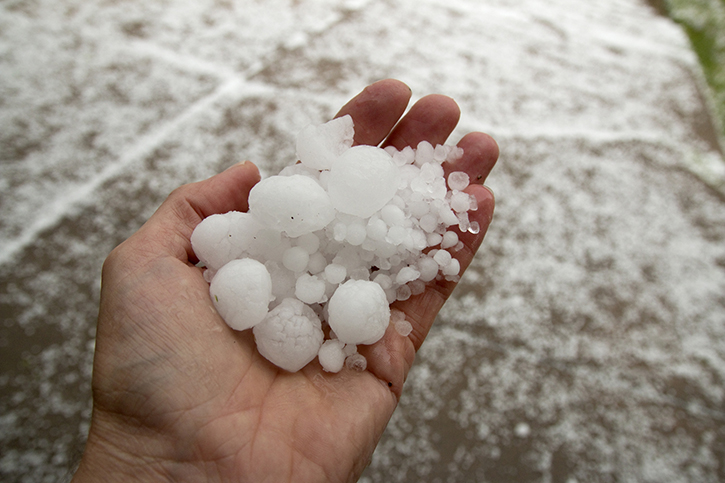Hail Insurance Payouts Skyrocket: Is This The New Normal?

When it comes to extreme weather, tornados and hurricanes get a lot of attention. But hail is a surprisingly destructive and expensive natural force. It’s so expensive that it has become a major concern for insurers in recent years.
Hail Insurance Pays Property Owners Billions Per Year
Insurance companies have had a very expensive decade. In the
Weather, Climate & Catastrophe Insight 2019 Report, Aon mentions that 2019 was the fourth year in a row that Severe Convective Storms (SCS) payouts came to more than $20 billion globally. And, according to their findings, “…this total was mainly driven by costly hail and wind outbreaks in the U.S.“
In 2019 the U.S. unofficially recorded 1,520 tornados, which was the highest number since 2011. But those numbers are small compared to the number of hailstorms.
NOAA’s Severe Storms database reported 4,611 severe hailstorms in 2020. Aon reported from 2007-2019, thunderstorm-related payouts have ranged from an estimated $8 billion to $14 billion per year.
Aon has concluded that, “[b]ased on the volume of annual claims filed in the past 12 years, it is safe to assume that the financial costs associated with hail have entered a new normal.”
Hail Insurance Claims: The Top 10 States
Texas, by far, had the highest number of hail insurance claims for the years 2017-2019 according to the Insurance Information Institute. The Lone Star state almost doubled the number of hail insurance loss claims filed –during those years. The top 10 states, ranked by number of hail loss claims 2017 – 2019 are as follows:
- Texas (637,977)
- Colorado (380,066)
- Nebraska (161,374)
- Minnesota (150,673)
- Illinois (150,416)
- Kansas (147,793)
- Missouri (133,704)
- Iowa (113,139)
- Indiana (63,892)
- North Carolina (58,342)
Why are Hail Insurance Payouts so High?
The answer may lie in a few key factors: increases in severe hail, population growth and increased population in hailstorm-prone regions. One might assume there would be a one-to-one correlation between the rate of increased hailstorms and hail payouts, but this is not the case. Insurance payouts have grown exponentially faster than incidents of severe hailstorms.
Increasing Frequency of Severe Hailstorms
The first potential cause of high payouts is the increasing frequency of severe hailstorms. Aon reports that
since 1990 instances of large hail have risen at a rate of roughly 2% per year.
The Science Daily reports that
“[h]ail severity will increase in most regions of the world . . . .” They state that incidents will decrease, but the size of hail will grow, leading to more severe damage.
But increased frequency isn’t the only reason for heightened insurance costs. After all, the rate of payouts is rising much higher than the rate of increased storms.
Increased Population in Hailstorm-Prone Regions
While instances of hailstorms have risen, they have not grown at the same soaring rate as payouts. Aon’s report suggests
this may be related to changes in population size and migration.
The World Bank cites that in
1960 approximately 66% of the world’s population resided in rural settings. In 2020 the percentage decreased to roughly 44%.
Most would assume this change was a direct one, in which people moved from rural areas to cities. However, a 2014 study by Stephen M. Strader and Walker S. Ashley posited that this change was more of an
“expanding bulls-eye”, where population grows not just in cities, but also in surrounding urban metro areas.
With the world moving into an “expanded bulls-eye” pattern, more of the world’s population now resides in areas that are prone to extreme weather. They write, “[t]he expanding bulls-eye helps to explain the amplification in disaster frequency and magnitude throughout time.“
Supporting this theory, Aon points out that the world locations with the highest hail risks – Dallas/ Fort Worth, TX, Denver, CO, Sydney, Australia, and Brisbane, Australia – all have seen large population growth in their metro areas.
Hailstorms are Here to Stay. How Can Property Owners Adjust to this New Normal?
As we have learned, larger and larger numbers of people are facing the risk of severe hailstorms and the cost of hail damage shows no sign of stopping.
So how can you help them to protect themselves? One way is to suggest weatherproofing measures against hail:
- Protect roof-mounted HVAC equipment with Hail Guards
- Maintain roofs and replace them when needed
- Choose roofs with steep slopes
- Choose impact-rated skylights
- Select fiber-cement siding
Invest in Hail and Wind Insurance
Wind and Hail insurance is another protective measure,
whether a property owner lives in one of the 19 states which require it or not. Wind and Hail insurance policies provide coverage that traditional homeowners insurance may deny.
When choosing a Hail and Wind insurance policy, it’s important that homeowners understand their benefits and deductibles. Most deductibles are based on a percentage of a property’s value. Policies structured in this way can lead to client frustration at the time of loss as they realize how much they must pay out-of-pocket before their benefits kick in. Homeowners find that some wind and hail insurance policies, like
Insurmark’s Mini-Wind, provide replacement cost without the necessity of insuring to value.
Unfortunately, increasingly severe hailstorms are the ‘new normal’ we face. We can’t change the weather, but as insurance brokers, we can make a difference by helping our clients select the wind and hail insurance that works for them.
This information is for general purposes only and is not intended to provide individualized legal or regulatory advice. All descriptions, summaries or highlights of coverage are for general informational purposes only and do not amend, alter, or modify the actual terms or conditions of any insurance policy. Coverage is governed only by the terms and conditions of the relevant policy.